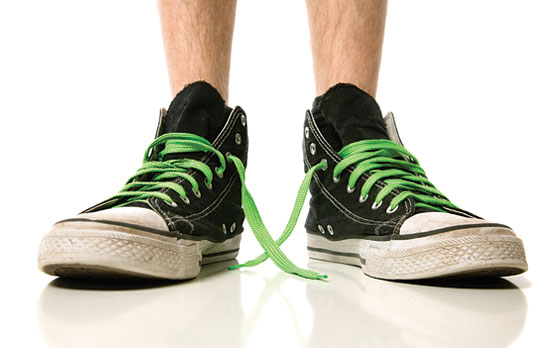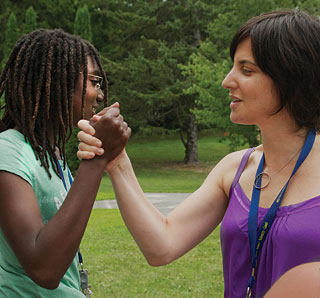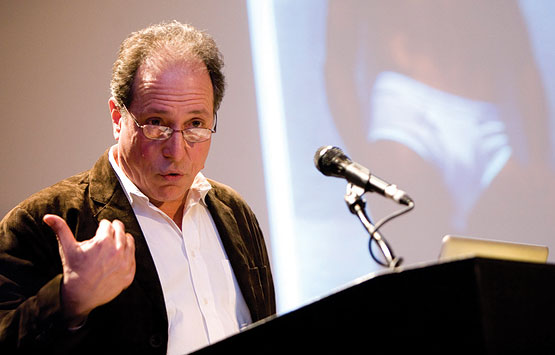Growing Pains

When does adolescence end and adulthood begin? What social influences now determine a teen’s path to maturity? Three Vassar alumnae/i—Michael Kimmel ’72, Abby Baird ’91, and Rachel Simmons ’96—are revealing shifting patterns in teen development, shedding light on the tumultuous adolescent years and the growing pains that often go along with them.

Sociologists note that entering adulthood typically has involved achieving all or most of five major markers: leaving home, completing one’s education, starting work, getting married, and having kids. Recent research suggests a newer set of alternate criteria: personal responsibility, autonomous decision-making, and financial independence.
By either set of measures, today’s teens are making the leap to adulthood in different ways than the generations before them. For example, Michael Kimmel, sociology professor at SUNY Stony Brook and author of Guyland: The Perilous World Where Boys Become Men, whose research focuses on masculinity, has found that most young men are now drifting into adulthood.
They’re completing the markers of adulthood later, if at all. Meanwhile, the period between adolescence and adulthood is growing ever longer, even constituting a separate stage of life. Moreover, teens are looking not to their parents and other members of older generations, but to one another for cues on making the shift from adolescent to adult. Kimmel points to fraternity hazing and other peer-defined rights of passage that, in theory, give the participant a kind of adult status.
According to Vassar psychology professor Abby Baird, such a peer-driven process is to be expected. “Adolescence is about peer approval,” she says. “Peers are the people with whom we ultimately mate, the people who form our social network, the people who populate the world in which we operate.”
Further, she says, “We’re evolutionarily wired to seek approval from peers who are just slightly older than ourselves.” Consider children who idolize slightly older siblings or members of a junior varsity sports team looking to the varsity players as role models.
Rachel Simmons, author of the bestselling book Odd Girl Out: The Hidden Culture of Aggression in Girls, tries to harness the positive power of peer relationships in her work with the Girls Leadership Institute (GLI), a nonprofit that empowers young girls. Some 200 young girls attended the institute’s summer camp at Smith College in Northampton, Massachusetts, earlier this year. Maddie Taterka ’14 was one of the camp counselors. “She’s not much older than the girls she’s taking care of,” Simmons explains. “The girls worship her and the other counselors, and listen to them in ways they won’t listen to someone older. They can see themselves in these younger role models. They think, ‘Maybe that will be me.’ That’s a kind of hope you can’t really teach. It comes in relationship with someone.” It comes in a relationship with a peer.
But the way in which adolescents experience peer influence is shifting. Teens are now doing much of their socializing online, and what happens in their virtual world of peers is having a real and lasting impact on the adults they’ll become.

All the Singled-Out Ladies
Girls, especially, place high importance on peer relationships, say Simmons and Baird. Consequently, it’s nothing short of disastrous in a young girl’s eyes when she finds herself excluded from the peer group to which she so desperately wants to belong. There’s a “hidden culture of aggression” among young girls, one in which there are bullies, victims, and bystanders, and in which the stakes—and lasting collateral damage—are high. Just ask Simmons.
She experienced bullying at the hands of girl peers during her youth. At Vassar, she focused on women’s studies, and as a Rhodes scholar at Oxford, delved deeper into the topic. “It was a way to exorcize old ghosts from my childhood and do something I felt really passionate about,” she says.
When Simmons tried to “go to the source,” as she’d been urged to do at Vassar, she discovered there essentially wasn’t a source. Instead, she forged ahead, interviewing hundreds of young girls, mothers, and other adult women who had once been an odd girl out. When Simmons’s Odd Girl Out was first published nearly 10 years ago, it was an instant hit, giving a voice and a language to a problem so many had experienced, but few had talked about. Simmons had become the source.
She found that society doesn’t sanction girls to express negative emotions and resolve conflicts in healthy ways. They must always be “the nice girl.” The desire for social status, conflict, and bottled-up emotions all come out in other ways: Relentless relational aggression. Nasty looks. Gossip. Rumor-spreading. Friendships held ransom or dissolved entirely. Social ostracism.
The result can be catastrophic for those on the receiving end of aggressive acts—and that can be just about anyone. As Simmons points out, “Everybody plays every role at some point—bully, victim, bystander. They rotate in and out of different roles, depending on relationships and other factors.”
The Digital Dilemma
In the 10 years since Odd Girl Out was first published, the landscape of peer interaction has changed, thanks to the advent of social media. So much so that in August, its publisher released a newly updated edition of Odd Girl Out, with revised content and new chapters, such as “BFF 2.0: Cyberbullying and Cyberdrama” and “Raising Girls in a Digital Age,” that relate directly to the impact of social media. While the jury is out on whether girls are actually more aggressive because of social media, or whether social media provides new ways of documenting aggression that already existed, or whether it serves as a new outlet for latent aggression, one thing is clear: the role of social media is too big to ignore.
Consider the rise of Facebook, the granddaddy of social networking sites at the ripe old age of seven. It surpassed 800 million registered users as of September. According to Facebook demographic information, some 72 percent of the U.S. population is on Facebook. In the 18 to 34 age bracket, 48 percent check it first thing in the morning when they wake up, sometimes without even getting out of bed.
The youngest generation of the Facebook flock—“underage” users below age 13, who aren’t supposed to have accounts or use the service—now totals an estimated 7.5 million kids, according to Consumer Reports. (This, despite Facebook removing some 20,000 such underage users per day.)
Increasingly, people—and especially youth—cannot function in the real world without also functioning in the virtual one. As Simmons notes, social media has become “a game changer.” “There is now a seamless integration between … virtual and real lives,” Simmons writes in Odd Girl Out. What happens online happens in real life.
Reinventing Relationships
“Technology has … altered girls’ everyday relationships, indeed girls’ very sense of self,” Simmons writes in the foreword to the new edition of Odd Girl Out. Those relationships and sense of self are as fragile as ever, at the very least because friend and foe are often one and the same person. “So much of what plagues girls happens within close friendship bonds,” Simmons says. “We have to explain to them, and show by example, where the line in friendship is. At what point does behavior cross over into aggression and bullying? Sometimes your best friend can also be your worst enemy.” Baird calls these Jekyll-and-Hyde peers “frienemies.”
Through her Girls Leadership Institute, Simmons is working to empower young girls to overcome such divisive and destructive behavior; to instead have more self-respect and self-confidence; to resolve conflicts in healthy, mature ways; to assert themselves positively; and to build stronger, more lasting bonds of friendship.
Teen girls entering grades 6 through 12 are eligible to attend GLI summer camp, where they do a lot of the usual summer camp things: eat together, make crafts, play sports, socialize, and play games. But they also make movies, role-play in improv theater, and, most importantly, participate in daily workshops such as “Responding to Pressure,” “Toxic Friendships,” “R U Mad at Me: Social Media and Friendship,” and “Four Steps of Conflict.”
Without the kind of emotional and social empowerment that comes through exercises like these, Simmons notes, the risk is that “a certain percentage of women [will] never recover from what they experienced in girlhood at the hands of other girls.”
“Helping girls deal with aggression doesn’t just pay dividends in the moment. We give them tools they will use across many contexts and many years,” Simmons says. “If girls allow their friends to hurt them, they believe that’s healthy, and they can import that attitude into their romantic, professional, and other relationships.”

The Unfinished Man
The single fastest-growing user group on Facebook is the 18 to 24 age bracket (growing 74 percent annually), an age group that—for males—sits squarely in the center of what sociologist Kimmel calls “Guyland.” For the inhabitants of Guyland, he says, the aggression is not covert, emotional, relational, as it is with girls and young women. It can be an overt aggression—physical, sexual, social—against one another and against women, as the guys sort out their social pecking order, establishing alpha males and their followers.
Kimmel earlier wrote Manhood in America, which some consider a definitive history of masculinity in the United States. But a few years ago, he says, a funny thing began happening. “Many of my colleagues started telling me about what they noticed on campuses. Women seemed to be really focused and directed. They had it all together, knew where they were going with careers, relationships, kids,” he explains. “The men were drifting. They didn’t really have a plan, a life vision. I began to wonder, started asking questions.”
What emerged from Kimmel’s research was a view of the developmental nether-region between adolescence and adulthood. What was once a transitional moment, Kimmel discovered, had become a full-fledged separate stage of life, with guys not actually becoming “adult” men until their late 20s, even 30. No longer teens, no longer adolescents, but not yet men, not yet adults, they are known as “preternatural Peter Pans,” “the unfinished man,” “twixters.” This new stage of life is being called “youthhood,” “emerging adulthood,” “the quarterlife crisis.”

Kimmel says that Guyland is governed by a “Guy Code,” and defined by a guy lifestyle, which he describes as both “party time” and “happy irresponsibility.” The lifestyle: Sex—either having it via serial heterosexual hook-ups or watching it via porn. (Kimmel does not consider gay men among the inhabitants of Guyland because “Guy Code” requires that men conform to heterosexual “norms.”) Binge drinking. Hazing (which may grossly cross the line of morality, legality, or both). Sports (obsessively playing them or talking about them). Video games. Frat-boy mentality. Machismo. Excessive risk-taking.
All of this takes place under the banner of “a continual eagerness or desperation to prove masculinity,” Kimmel explains. “It’s about manhood. But, it’s more about entry into ‘the club.’ I believe guys often confuse the two. They confuse acceptance by your peers with the validation of manhood.”
The result is a curious juxtaposition. On the one hand, the guys of Guyland have inherited and perpetuate conservative, outdated gender stereotypes. On the other hand, Kimmel notes, today’s residents of Guyland hold very different views about the world than did their fathers and grandfathers. Today’s guys assume their future wives will work and be committed to a career; assume that, as fathers, they will be involved parents, much more so than their own dads were; and embrace a day-to-day equality with women (in the workplace, in platonic opposite sex friendships). “This is an area of real substantive change,” Kimmel says.
The Teen Species
Of course, teens—whether young girls battling online and relational aggression, or guys temporarily “stuck” in Guyland—eventually do become adults. Which begs the question, what is it about the teen years that makes the transition into adulthood so bumpy? Few know more about that than Vassar psychology professor Abby Baird, whose book, “The Teen Species,” is due out in 2012. She studies teen neuroscience by comparing the teen and adult decision-making processes while imaging subjects’ brains.
She started her career doing brain-imaging work with schizophrenic and bipolar young adults. Too often, these individuals were more or less fine until puberty, at which point “things went off the rails,” Baird says. Why? What happens to the brain during puberty? “I thought I’d figure out what happens, what goes wrong, and fix it,” she says. To her surprise, there were “almost zero” peer-reviewed articles on the brain and puberty. “How could we not know what happens during adolescence?” she asks. “I could not find anything about the interaction of brain and behavior at this critically important stage of development.” Like Simmons, Baird set out to find the answers for herself.
Some of her findings have been surprising. For example, much of what happens during the teen years is often considered foolish, carelessly dangerous, and immature. When looking at teens, this leads many adults to wonder, “What were they thinking?” The default assumption is that they weren’t thinking; that teens, by virtue of their still-developing brains (and especially, the underdeveloped frontal lobe, responsible for reasoning, decision-making and other executive functions), are inherently impulsive.
That’s partly true, but not so fast, Baird argues—teens may actually be thinking too much. “Poor adolescent decision-making is not a result of cognition,” Baird explains. “They know what’s good for them and what’s not.” Other forces in the brain are at work.
For one, especially when it comes to risky, dangerous or other “negative” choices, adults and teens process decisions in entirely different ways. In adults, “gut instinct” kicks in, calling upon visceral learned reactions built through a lifetime of previous experiences. “That sense is so automatic in adults, we don’t realize it hasn’t always been there,” Baird explains. In teens, her research reveals, none of those areas of the brain is active; teens haven’t had enough life experience to develop automatic reactions to potentially negative circumstances; their instinctual decision-making system isn’t developed yet. Instead, the frontal lobe is most active. They’re trying to reason out a decision in a situation for which they don’t yet have a preprogrammed model.
This balance (or lack thereof) between the emotional, instinctual parts of the brain and the abstract, reasoning parts helps to explain the behaviors we see in adolescents. Consider Baird’s “imaginary audience” research focused on young teen girls. Baird studied their brains and decision-making process when the girls thought other people were watching them, and when they didn’t. When girls aren’t concerned about others’ eyes on them, their frontal lobe—still in development—tries to reason out decisions. But as soon as girls think their peers are watching, the frontal lobe “shuts off,” Baird says, and the emotional, fight-or-flight parts of the brain light up … for making the exact same decision. “These girls go into DEFCON 3,” Baird explains. (The acronym is military-speak for “all systems on alert.”) But for that system to operate well, it needs cumulative exposure to relevant incidents, so that the brain builds up its automatic, emotional, gut instinct. Teen girls—and teen boys—don’t have that experience. Not yet.
No Substitute for Experience

Baird’s research has shown that teens’ brains—and their persons—need the benefit of experiences, both positive and negative, to learn to function as better human beings, as eventually mature adults. “Young kids need lots of opportunity to practice, but we’re giving them less and less real-world experience,” she says.
A number of factors are to blame, she says, just one of which is the trend toward overly protective, helicopter parenting. Adolescents aren’t given ample chances to practice being adults, aren’t allowed to fail or face challenges and pick themselves up and persevere, and so—in the case of Guyland—they come to adulthood later, having taken longer to accumulate the requisite life experience.
Simmons contends that, in order to empower young girls to face peer aggression, relationships need to be the “fourth R” in schools. She says, “We teach them math and history and science, how to sit still, how to do homework. Communication is a highly skilled activity. They don’t wake up knowing how to do it. Yet society expects they’ll know.”
Because teens look more like adults, talk more like adults, and think more like adults, we tend to treat them like adults, says Baird. But they’re not. Infact, she finds that—as it relates to the brain—females don’t reach adulthood until age 20 to 23 or so, while males typically don’t reach that same level of brain maturity until age 25 (or later), which helps to explain why Kimmel and his colleagues noted that college girls had their acts “together,” while college guys still seemed to be “drifting.”
In other words, the adult stage of life is coming soon, but it is still en route. In the interim, adolescents need guidance to navigate their inevitable growing pains.
Where to Grow From Here
Baird, Simmons, and Kimmel know that no one will ever completely calm the choppy waters of adolescence. Rather, by understanding what teens experience, they hope to better enable teens to navigate their adolescent years.
“As a stage of development, everyone will go through the transition from adolescent to adult,” Kimmel says, “but how you go through it will vary tremendously.” For instance, not every guy will enter Kimmel’s Guyland. “It’s not the only game in town,” he admits. Some guys will transition more directly from adolescence to adulthood, or make that transition via an alternative social pathway. But, Kimmel quickly adds, Guyland is the dominant social world, one with which almost every guy—and girl—will interact, even if he or she chooses a different social scene for his or her own.
Similarly, while the relational aggression of Simmons’s Odd Girl Out predominantly affects adolescent girls, it is not confined to that age group, or to that gender. Younger girls and adult women may face it. And some guys will experience it, too.
“Adolescence,” even if different today than it was a decade or more ago, “is purposeful and essential for normal development,” Baird says. “People tend to pathologize adolescence, but it’s training to become an adult. If it weren’t so important, it wouldn’t exist.”
